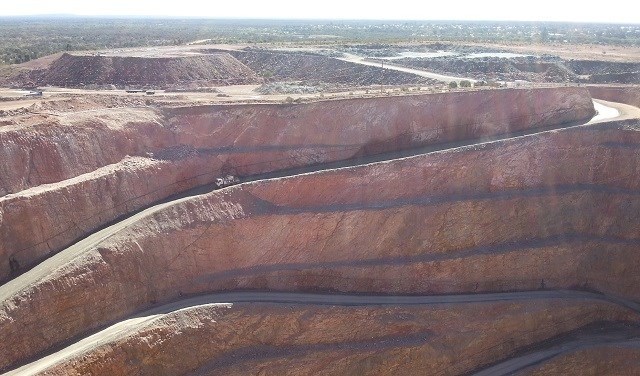The Great Cobar Copper Mining Company Limited was established in 1878. It and subsequent companies operated a number of light railways carrying ore and similar material, as well as timber for mine supports. Cobar and many mining outskirts accommodated the miners who travelled to the area in the late 1880s. The overwhelming majority of these were of Cornish Australian stock at the time. Several fine heritage buildings from the late 1880s/early 1900s settlement are still in existence, including the Great Western Hotel (1898), reputed to have the longest iron lace veranda in the Southern Hemisphere, the Cobar Court House (1887) and Court House Hotel (1895) in Barton Street, as well as the interesting Cobar Heritage and Visitor Information Centre, located in the beautiful former Mines Office (1910). Here we were told there are plans to reopen the original Great Cobar mine as it still holds much Copper at greater depths than could be economically reached in the early 1900’s. At its peak, Cobar had a population on 10,000 and its own stock exchange. However, copper mining operations slowed in 1920, and by the 1930s the town's population had dropped to little over 1,000, only to rise again and stabilise at around 3,500 through the 1970s and early 1980s When full-time operations resumed In the 1980s, Gold, silver, lead and zinc were discovered in the area, which led to a further population increase
(While you are there don’t forget to look for Fort Bourke the great trad near here.)
You will need to travel out the Hillston Road southeast out of town to Fort Bourke Hill lookout which affords an excellent view of the New Cobar Mine, the township, as well as the historic Towser's Huts, a series of stone miners' cottages dating back as early as the 1890s, possibly even the 1870s, and built by an Italian miner by the name of Antonio Tozzi.
History of the Cobar Mine.
The Old Cobar mine started this pit in the late 1890’s but by the early 1900’s was closed due to being uneconomical. In 2001-2002 using modern equipment the pit was extended to 150mts deep 200mts wide and 300mts long as you see it today. A total of 3.6 million tonnes of waste rock was remover and stockpiled on the Western side.
The New Cobar Mine commenced production in 2004 and is now joined to the Chesney mine. Recovered gold carried up these haul roads is smeltered to produce gold bullions weighing approximately 15kg each. One gold bar represents 1 to 2 days production.

Geology.
The Cobar mineral field lies within the Cobar basin, a 250km long and 50km wide basin which formed more than 400 million years ago
The mineral deposit with in the Cobar mineral field formed in the later compressional phase of the Cobar Basin. The rich deposits form along the faults which controlled the basin formation. They allowed deep crustal fluids to penetrate into the upper crust. These hydrothermal fluids carried metals especially Copper, Gold, Lead, Zink and Silver through the fault lines.
In its purest form gold is a slightly reddish yellow dense, soft malleable and ductile metal. Gold is one of the least reactive chemical elements and is solid under standard conditions.
The most common natural method of concentration of gold is through the ancient action of hot fluid inside the Earth's crust. (Fluids deep in the crust are heated by the Earth's internal heat. As they move towards the surface they cool down.)
The fluids moved through the rocks over a large area and "dissolves" the gold. When these fluids cooled or reacted with other rocks the dissolved gold precipitated (came out of the fluid) in cracks or fractures forming veins.
As well as gold, the fluids carried other dissolved minerals, such as quartz. This is why gold is often found with quartz. These are known as primary gold deposits and to extract the gold the rock containing the veins of gold has to be dug up (mined), crushed and processed.

In Australia this concentration of gold took place in the Earth many millions of years ago.The rocks containing the gold veins have now been exposed on the surface and are eroding away. The gold that these rocks contained has been washed down into creeks to form alluvial gold deposits. Here, the gold is further concentrated by the action of water.
Because gold is heavier than most of the material moved by a creek or river, it can become concentrated in hollows and trapped in the bed of the river. These are known as secondary or Alluvial gold deposits and they can be worked using a gold pan, cradle.

To Log a find email or message us the answers to the following questions:-
At. the above coordinates look South West, you will see the old Chesney Headframe, this now acts as a ventilation outlet taking used air from the mine. Fresh air is drawn in down the New Cobar decline. This shaft also acts as an emergency egress and a utilities access route. This will give you an idea of the size of the operation, now head to the lookout behind you.
Q1/.. The Name of this Earth cache.
Q2/.. What is the chemical symbol for gold?
Looking northward in the pit you will see a large quartz vein; this is the Great Chesney Fault which controls the New Cobar mineralisation and extends southwards to the Chesney and Occidental deposits. The shafts you see were created by miners in the late 1800’s to early 1900’s to remove the Gold and Copper.
Q3/.. Describe the shape of the fault and tell us how it differs from the rest of the pit.
Q4/.. Would you describe the gold being mined here as being a Primary or Secondary deposit?
References
Local Shire
Tourist information Centre.
Wikipedia